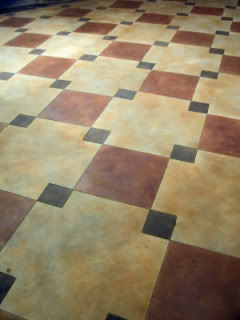Unique Ideas for Dyeing a Concrete Floor

Let’s face it, with all concrete has to offer, it’s still gray and boring. But all that can change with concrete dyeing. If you like concrete because of its longevity and durability, it can also be an appealing addition to your home. A special dye can be applied to the concrete which penetrates the surface and changes the appearance of the material. It comes in a wide variety of colors and dries quickly.
Because the dye reacts with the concrete, variations and inconsistencies usually occur. However, for most people this adds to the appeal of the dye because it creates a more natural, unique look. The once-boring, gray slab of cement can now be colored, patterned, or finished to look like other surfaces.
Design Ideas
There are virtually endless possibilities when it comes to designing and coloring your concrete floor. However, because the procedure requires special equipment and potentially dangerous chemicals, it’s best to hire a professional concrete contractor.
One option is to give the surface an aged, spotted look. This is done by applying a base coat, and then on top a contrasting color is dabbed on with a cloth or sponge. Another idea is to add decorative stone studding around the edges as a border.
Another great way to personalize your concrete is by applying patterns. These are stencil-like molds that are pressed onto the wet concrete surface, leaving an imprint. The imprint can give an illusion of Boston-like cobblestones, flagstones, bricks or any other pattern you can think of. You can also dye different parts of the pattern different colors. For instance, you can create a checkered pattern, or have a border or rim in a different color. As opposed to real stones, stone-patterned concrete will not shift, become elevated or depressed, and won’t allow moss or weeds to grow from beneath the surface and protrude.
If you don’t have the ability to create or get ahold of a mold, one alternative is to use household items as stamps. Another method is to apply duct tape over part of the surface and dye the area around it. This is a great way to incorporate the natural gray color of concrete into a more intricate, aesthetic look.
You can also saw lines into the concrete to create a mosaic look, or apply a mosaic-shaped mold to the surface. Once the cuts are made you can stain each small “tile” a different color. You can create darker and lighter areas by staining some sections for longer. You can blot-up wet spots and create lighter marks, or you can sprinkle sawdust or san to create a bumpy, mottled look.
While concrete is a durable, weather-proof material, the same doesn’t apply to the dye – direct exposure to the sun can cause the color to fade over time. Therefore, if you’re interested in installing dyed concrete outside, you may want to consider consulting with a floor contractor and consider alternatives. However, there are UV-resistance sealants that can be applied to the concrete if that is the only option.
Dyeing your concrete floor will add both appeal and value to your home. However, before deciding on what to do it’s a good idea to look at pictures or visit places where dyed and/or stamped concrete has been installed. This will give you a more realistic idea of what to expect, as well as provide inspiration for your own ideas.
Mark Stevens is a writer from New Jersey who has written over 100 home improvement articles. Want to ask Mark something? Send him a message.
Looking for a Pro? Call us (866) 441-6648

Concrete Average Costs
Concrete Contractors Experiences

The Stamped Concrete Patio I’ve Been Waiting For

We Finally Extended Our Concrete Patio And Our Yard Looks Amazing



